Are you looking for cheap and easy ways to soundproof a door at home? Soundproofing your door can be a quick and easy way to make your house quieter, so you can finally sleep in peace or not be disturbed by unwanted sounds from outside your room.
To help you know what to do, we’ve put together this quick guide on how to soundproof a door with 11 simple tips to follow to minimize the sound. Let’s get started.
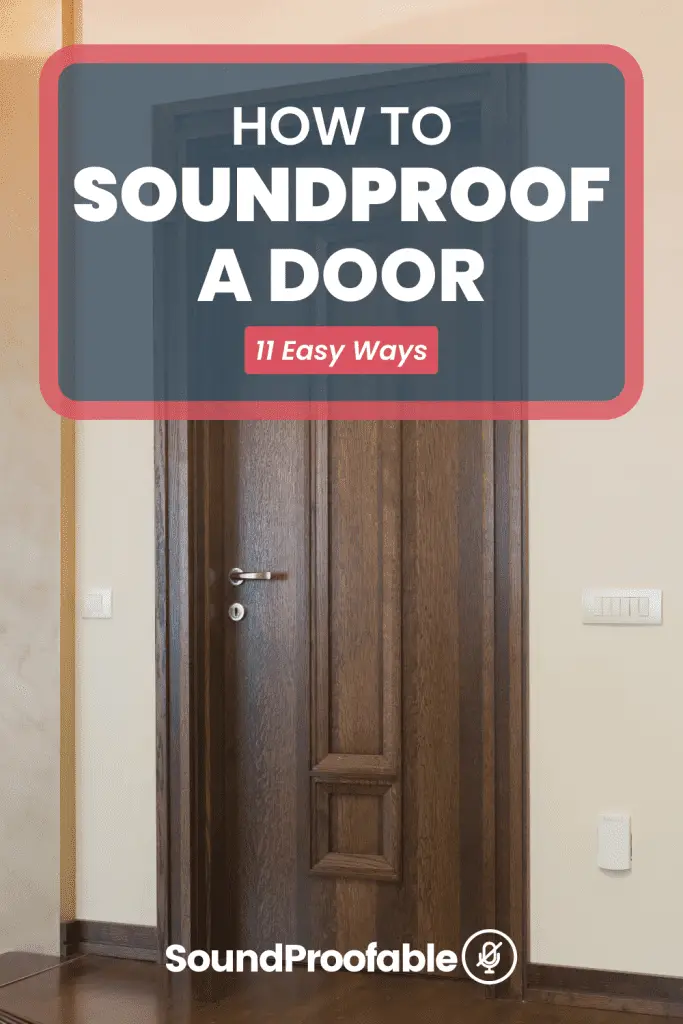
Table of Contents
What Type of Door do you Have?
Before we start, the first thing you’ll need to do is find out what type of door you have. The most common doors are:
- hollow core doors
- solid core
- metal
- glass
The best doors for keeping away sound are solid core doors as these have more mass. Hollow doors are the worst. Metal doors and glass doors are different and we’ll cover those in their own articles.
One of the biggest mistakes people make is assuming they can use the same soundproofing techniques for all doors, but this isn’t always true. For example, you won’t be able to add insulation to a glass door as you won’t be able to see out of it. And if you have a hollow door, it’s going to be a lot harder to drill things into it
For more information, read our article on how to soundproof a hollow door here.
So just note that some of the methods we list below will work on some types of doors, but not on others.
Why are Doors Bad for Sound Leakage?
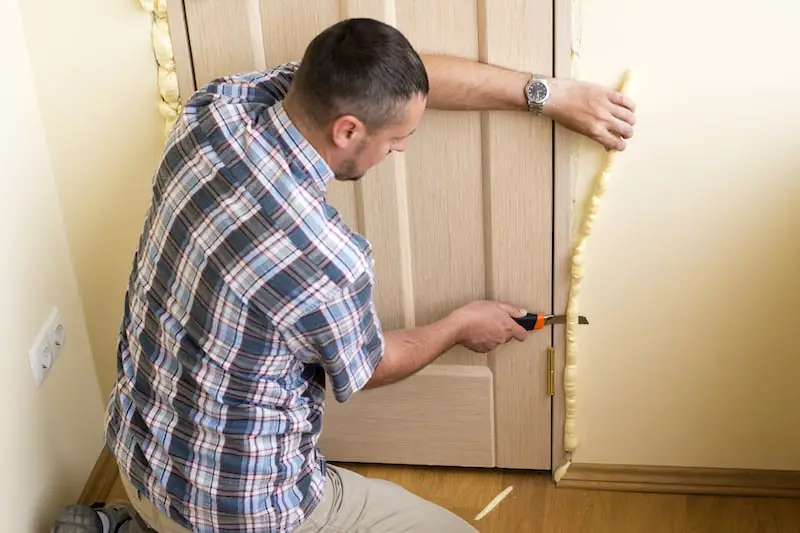
Doors are notoriously bad for sound leakage and are often the first thing you should look to soundproof when trying to reduce the amount of noise in a room.
There are a number of reasons why which we’ll cover below.
They usually have a large gap at the bottom of the door – Most doors will have a large gap at the bottom and won’t quite touch the floor. While this makes it easier to open and won’t scratch the floor underneath, it’s not so good when it comes to soundproofing as sound can pass right underneath it.
They have gaps around the edges – As well as the gap at the bottom of the door, every door will have a gap around the edges that allows air and sound to pass through. This is the easiest thing to fix and we’ll cover how to best do it shortly.
They have cracks and gaps around the frame – Another entry spot for sound through doors is not on the door itself, but in the gaps and cracks where the frame meets the wall. This again is an easy fix which we’ll cover later but it’s something to inspect on your door to see if your door is leaking sound that way.
They’re usually made from non soundproof materials – Doors are made for privacy and while they naturally create a sound barrier just by being there, the materials typically used on interior doors are not the best for soundproofing and so will take a bit of work to give them better soundproofing qualities.
Door Soundproofing Principles
When it comes to soundproofing a door there are a few different principles we want to keep in mind when deciding what to do.
We want to put as much mass between the door and the outside – Adding more mass helps to prevent sound waves from penetrating through the door and reaching our ears. This can be done by getting a thick, solid core door or by adding as many materials to the door as you can.
We want to prevent sound from escaping through any gaps – Sealing gaps and cracks on either side of the door is also essential to achieve a well-soundproofed door. If air can pass through, then so can sound so we’ll be looking to plug any of these gaps using a door gasket or soundproofing caulk.
Our 11 Door Soundproofing Tips
With that all out the way, it’s now time to get down to some useful tips and tricks for soundproofing a door.
So let’s start with number one.
1. Add Rubber Weatherstripping Around the Door
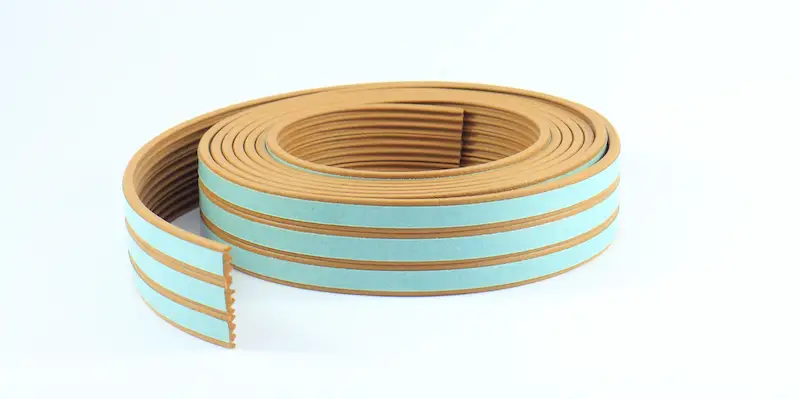
An easy and quick way to soundproof a door is by using some rubber weatherstripping. This is probably the most basic and inexpensive way to soundproof a door.
Weatherstripping usually includes a strip of 3/8 inch foam or rubber that you stick along the door jamb and to the frame of the door to close and seal as many of the gaps as possible.
If there are gaps around the door it’s an easy place for a large amount of sound to leak through and so simply making this gap smaller will help to achieve a better soundproof door.
We recommend something like this one here for not much money and will take a few minutes to put up.
2. Put up Soundproof Blankets
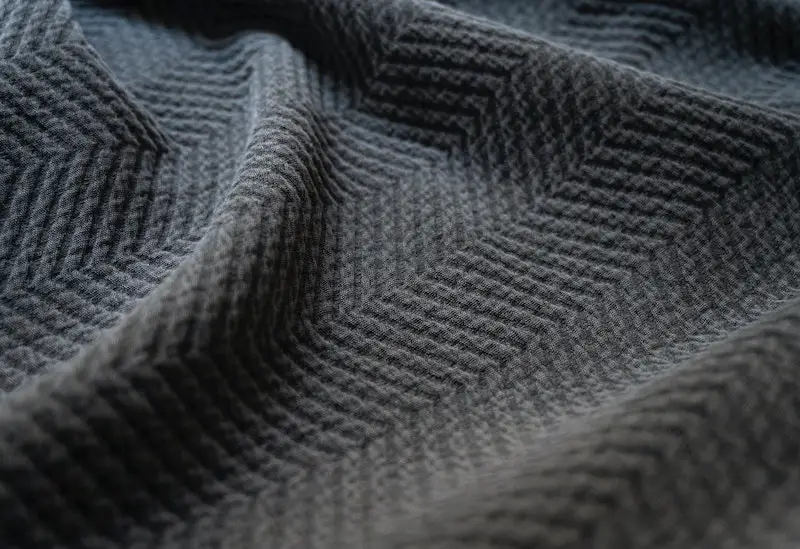
Next on the list of easy ways to soundproof a door is by using some soundproof blankets to cover the door. A soundproof blanket is usually made out of thick or dense materials and can make a big difference in adding mass and absorbing sound to help stop it in its tracks.
When it comes to putting them up, you can either attach them permanently and make sure they stay attached with some Velcro or tacks or you can use something like duct tape to temporarily stick them in place. You could even just hang them over the door for a very temporary quick fix.
It really depends on what the door is made of, how often you think you’ll need to take it off and put it up again, and how long-term you want your soundproofing solution to be.
For best results, we recommend these soundproof blankets as they’re a good value for money and designed specifically for sound absorption.
If you’re on a tight budget, you can use any old moving blankets like these but just remember, the thicker the blanket, the better for soundproofing.
3. Use Sound Absorbing Curtains to
While soundproof blankets are great for absorbing sounds, they aren’t going to look very good on your door. If you still want to use something like that but need something more aesthetically pleasing, then getting some soundproof curtains can be a good option to look at.
They work just like the soundproof blankets and will do a great job of getting in the way of sound waves and absorbing some of those unwanted noises from outside.
You can also use them to cover up windows or other gaps in the room if needed.
The only downside with this method is that you have to deal with putting them up which can involve installing a curtain rail above the door. This isn’t always possible, especially if renting and want to soundproof a door in an apartment.
We recommend these soundproof curtains from NiceTown which are specifically made to absorb sound and aren’t too expensive.
4. Attach Acoustic Foam Panels to the Back of the Door
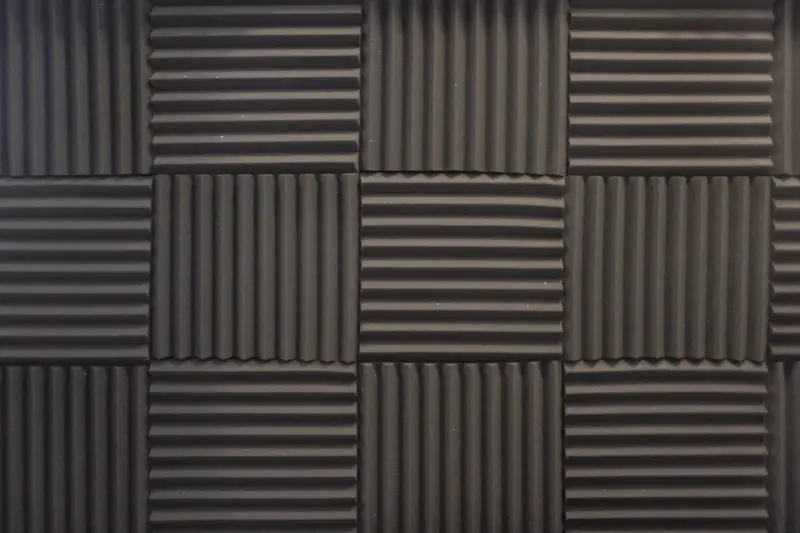
If you want something a little more permanent and don’t want to have to deal with installing any kind of curtain rails, then covering the back of the door with some acoustic foam panels is another good option.
Acoustic panels are usually made from dense foam materials like that are designed to absorb sound waves and reduce the level of noise coming through them. They’re what you usually see covering every surface in music studios.
They’re much easier to install than any kind of window coverings and can be removed easily while still looking neat and tidy for temporary use. For best results, we recommend these ones here which come in a large pack so you can use them on multiple doors or walls around the house.
5. Install a Door Sweep
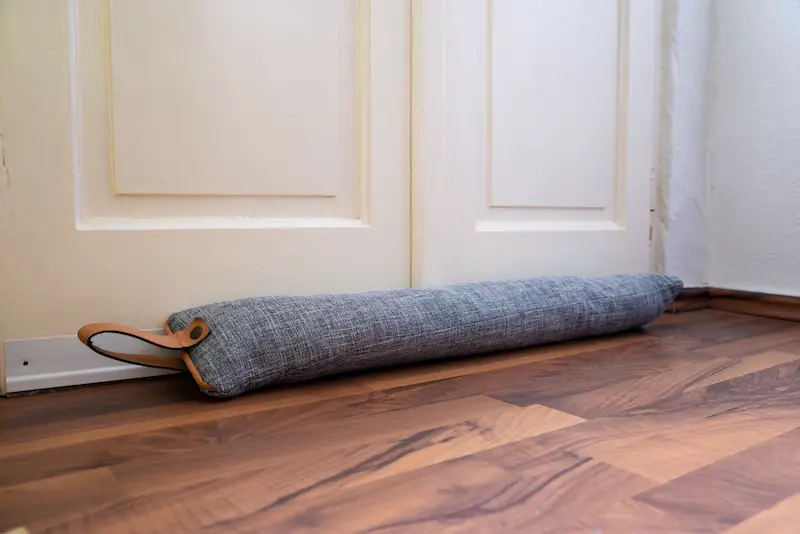
The next way to soundproof a door is by installing a door sweep to the bottom of the door. You’ve probably seen a door sweep before as they are often used to keep out drafts.
The way they work is by basically filling the gaps around the bottom of a door to stop air and sound from escaping under the door and help reduce how much sound can travel through them.
You can install more permanent door sweeps like these ones here which are best, but that will require you to get out your power drill. For a more temporary and quick fix, any sort of draft excluder like these will help but you won’t get as good results.
6. Replace the Threshold
If the gap between the door and floor is too big and installing a door sweep still leaves a gap then that can cause noise to travel through the floor and reduce how much soundproofing you get. To fix this, replacing a worn or damaged threshold and adding in something more solid can be the solution.
This will mean getting out a power drill again as well as measuring up that replacement piece properly to make sure it fits right. Otherwise, you could wind up with an ugly-looking gap there or a door that doesn’t open properly anymore.
If none of these methods are possible for your situation (renting etc.), then we recommend going with one of these pre-made rubber seals which should work just as well when stuck around the bottom half of the door while still being flexible enough to let your door swing open fully.
7. Seal any Gaps with Acoustic Caulk
Similar to door sweeps, caulking any gaps and cracks between the door frame and the surrounding walls can also help to seal the gaps and stop sound from escaping or entering your room.
The first and easiest way to do this is just by using some regular old caulk. You then want to apply it along the space where the wall meets the door frame around all sides of it.
But, you can get specifically designed sound absorbant caulk that will help to prevent sound from escaping better. We recommend Green Glue which is the most popular brand.
8. Place Rugs in Front of the Door
Another easy way to get a soundproof door is by simply placing a rug right in front of it which will help to absorb the impact of any sounds hitting the floor.
Any way to prevent soundwaves from even reaching the door will help and so if you can place one on either side of the door that’s even better.
As with blankets and curtains, thicker rugs are better for absorbing sounds and so if possible, go for something as thick as possible that will really get in the way of soundwaves and reduce how much noise reaches your ears.
9. Install a Door Gasket
Door gaskets are like weather stripping that will help to prevent air and sound waves from escaping around the sides of the door. Not only will door gaskets help to prevent sound from getting in, but they’ll also help to cut out light, drafts, moisture and even smoke during a fire.
They’re typically made of metal and are installed around the entire frame to create a door seal. As a result, they will take more effort to install as you’ll need to mount them using screws to the door frame.
The rubber weatherstripping we covered earlier is a cheap form of gasket and so if you don’t want to go through the trouble of installing more permanent gaskets try that first.
10. Use Mass Loaded Vinyl
Another soundproofing material that some people like to use is MLV or Mass Loaded Vinyl. This is usually used in recording studios and cars but can be installed to cover any surface you like.
MLV is very dense and is used to block sound and increase the density of your door. It’s often used on hollow doors by attaching it to the back to increase it’s mass and therefore making it more soundproof.
11. Replace with a Solid Core Door
Lastly, if you’ve tried some of the above tips and are still having trouble, it might be time to start looking at replacing your door altogether. If you’re working with a hollow core door, there’s only so much you can do to prevent sound from getting in.
A solid core door made from solid wood on the other hand will be better at preventing any sort of sound from getting through it in the first place than most hollow doors.
They look much like typical hollow doors but are made with a bit more reinforcement to prevent them from rattling or allowing sound waves to pass through them as easily. The other benefit is that they’re far more secure and so if you’re worried about people breaking into your home then these could also help with that too.
They are considerably more expensive however so we’d recommend trying the above tips first before purchasing one.
Summing up
As you can see, there are lots of different methods you can use for soundproofing a door. The best, most effective way to do so though is by installing a solid core one and replacing your current hollow or thin wooden doors with it.
But, the other tips on our list are quick ways to start improving how well insulated your environment is against sounds by starting with your door and some simple DIY fixes that are inexpensive and provide decent results.
We hope this article helped you on how to soundproof a door in your home. Good luck!
